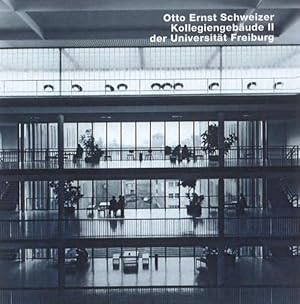kollegienebaude universitat de schweizer ernst (1 resultados)
Tipo de artículo
- Todo tipo de artículos
- Libros (1)
- Revistas y publicaciones
- Cómics
- Partituras
- Arte, grabados y pósters
- Fotografías
- Mapas
-
Manuscritos y
coleccionismo de papel
Condición
- Todo
- Nuevos
- Antiguos o usados
Encuadernación
- Todo
- Tapa dura
- Tapa blanda
Más atributos
- Primera edición
- Firmado
- Sobrecubierta
- Con imágenes del vendedor
- Sin impresión bajo demanda
Ubicación del vendedor
Valoración de los vendedores
-
Otto Ernst Schweizer, Kollegienebaude II, Universitat Freiburg (Hardcover)
Publicado por Edition Axel Menges, Fellbach, 2015
ISBN 10: 3932565738ISBN 13: 9783932565731
Librería: CitiRetail, Stevenage, Reino Unido
Libro
Hardcover. Condición: new. Hardcover. Text in English & German. With the Kollegiengebaeude II (college building II) of the University of Freiburg dedicated in 1961 the architect Otto Ernst Schweizer had achieved a masterpiece. Being built in the modern design idiom, it nevertheless took Freiburg's tradition into account and gave a new quality of life to the university and the urban development of the inner city quarters. On the whole it was a significant stimulus to university construction. Thanks to the neutral expression of the building, its compact overall for m and its "elastic structural system" (there is maximum flexibility in room layout without touching the bearing skeleton), and together with the laconically simple floor plan it became a prototype solution for smooth functioning. It is an open architecture, free of any suffocating pathos, with wide open spaces, human scale in size and proportions and in ideal accordance with academic freedom for research, instruction and learning. Schweizer, born in 1890 and deceased in 1965, professor of urban construction at the Technical University of Karlsruhe is one of the ground-breaking architects of the 20th century. In the late 1920s he gained international renognition and relevance with his buildings in Nuremburg, among them the stadium grounds and the Milchhof, as well as the Prater-Stadion in Vienna. During the 1930s, when he was not allowed to build, he studied fundamental questions of architecture and urbanism. After the Second World War he used his insights to make recommendations for the reconstruction of destroyed cities like Giessen, Karlsruhe, Mannheim or Stuttgart. In his last project, the Kollegiengebaeude II we find the quintessence of a rich creative life, convincingly demonstrating Schweizer's high demands on architectural form and function. Immo Boyken is professor emeritus of building history and theory of architecture in Konstanz. His special interest is the architecture of the late 19th and the 20th century. He was a principal contributor to the monograph on Egon Eiermann, author ed the monograph on Otto Ernst Schweizer and lately wrote about Heinz Tesar's church in the Donau City in Vienna (Opus 42), the chancellery of the German embassy in Washington by Egon Eiermann (Opus 54), the Milchhof in Nuremburg by Otto Ernst Schweizer (Opus 59), the Prater-Stadion in Vienna (Opus 75) also by Schweizer, and the German Pavilions at the World Exhibition 1958 in Brussels by Sep Ruf and Egon Eiermann (Opus 62). Aims to trigger wide public debates about the central issues within the 21st-century public challenge to architecture about how contemporary architecture should intervene in an existing urban environment with clear historical values, using the full potential inherent in modern society. Shipping may be from our UK warehouse or from our Australian or US warehouses, depending on stock availability.


